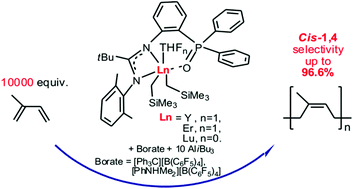Bis(alkyl) rare-earth complexes supported by a new tridentate amidinate ligand with a pendant diphenylphosphine oxide group. Synthesis, structures and catalytic activity in isoprene polymerization†
Abstract
A new tridentate amidine 2-[Ph2P(O)]C6H4NHC(tBu)![[double bond, length as m-dash]](https://www.rsc.org/images/entities/char_e001.gif) N(2,6-Me2C6H3) (1) bearing a side chain pendant Ph2P
N(2,6-Me2C6H3) (1) bearing a side chain pendant Ph2P![[double bond, length as m-dash]](https://www.rsc.org/images/entities/char_e001.gif) O group was synthesized and proved to be a suitable ligand for coordination to rare-earths ions. Bis(alkyl) complexes {2-[Ph2P(O)]C6H4NC(tBu)N(2,6-Me2C6H3)}Ln(CH2SiMe3)2(THF)n (Ln = Y, n = 1 (3), Ln = Er, n = 1 (4), Ln = Lu, n = 0 (5)) were prepared using alkane elimination reactions of 1 and Ln(CH2SiMe3)3(THF)2 (Ln = Y, Er, Lu) in hexane and were isolated in 50, 70 and 75% yields respectively. The X-ray studies revealed that complexes 2–5 feature intramolecular coordination of P
O group was synthesized and proved to be a suitable ligand for coordination to rare-earths ions. Bis(alkyl) complexes {2-[Ph2P(O)]C6H4NC(tBu)N(2,6-Me2C6H3)}Ln(CH2SiMe3)2(THF)n (Ln = Y, n = 1 (3), Ln = Er, n = 1 (4), Ln = Lu, n = 0 (5)) were prepared using alkane elimination reactions of 1 and Ln(CH2SiMe3)3(THF)2 (Ln = Y, Er, Lu) in hexane and were isolated in 50, 70 and 75% yields respectively. The X-ray studies revealed that complexes 2–5 feature intramolecular coordination of P![[double bond, length as m-dash]](https://www.rsc.org/images/entities/char_e001.gif) O groups to metal ions. The lutetium complex 5 proved to be rather stable: at 20 °C its half-life time is 1155 h, while for the yttrium analogue the half-life time was found to be 63 h. Complexes 3–5 were evaluated as precatalysts for isoprene polymerization. The systems Ln/borate/AliBu3 (Ln = 3–5, borate = [PhNHMe2][B(C6F5)4], [Ph3C][B(C6F5)4]) turned out to be highly efficient in isoprene polymerization and enable complete conversion of 1000–10 000 equivalents of monomer into polymer at 20 °C within 0.5–2.5 h affording polyisoprenes with a very high content of 1,4-cis units (up to 96.6%) and from narrow (1.49) to moderate (3.54) polydispersities. A comparative study of catalytic performance of the related bis(alkyl) yttrium complexes supported by amidinate ligands of different denticities and structures [tBuC(N-2,6iPr2C6H4)2]−, [tBuC(N-2,6-iPr2C6H4)(N-2-MeOC6H4)]− and {2-[Ph2P(O)]C6H4NC(tBu)N(2,6-Me2C6H3)}− demonstrated that the introduction of a pendant donor group (2-MeOC6H4 or Ph2P(O)) into a side chain of amidinate scaffolds results in a significant increase in catalytic activity. The amidinate ligand bearing a Ph2P(O)-group provides a high isoprene polymerization rate along with excellent control over regio- and stereoselectivities and allows us to obtain polyisoprenes with a reasonable molecular weight distribution.
O groups to metal ions. The lutetium complex 5 proved to be rather stable: at 20 °C its half-life time is 1155 h, while for the yttrium analogue the half-life time was found to be 63 h. Complexes 3–5 were evaluated as precatalysts for isoprene polymerization. The systems Ln/borate/AliBu3 (Ln = 3–5, borate = [PhNHMe2][B(C6F5)4], [Ph3C][B(C6F5)4]) turned out to be highly efficient in isoprene polymerization and enable complete conversion of 1000–10 000 equivalents of monomer into polymer at 20 °C within 0.5–2.5 h affording polyisoprenes with a very high content of 1,4-cis units (up to 96.6%) and from narrow (1.49) to moderate (3.54) polydispersities. A comparative study of catalytic performance of the related bis(alkyl) yttrium complexes supported by amidinate ligands of different denticities and structures [tBuC(N-2,6iPr2C6H4)2]−, [tBuC(N-2,6-iPr2C6H4)(N-2-MeOC6H4)]− and {2-[Ph2P(O)]C6H4NC(tBu)N(2,6-Me2C6H3)}− demonstrated that the introduction of a pendant donor group (2-MeOC6H4 or Ph2P(O)) into a side chain of amidinate scaffolds results in a significant increase in catalytic activity. The amidinate ligand bearing a Ph2P(O)-group provides a high isoprene polymerization rate along with excellent control over regio- and stereoselectivities and allows us to obtain polyisoprenes with a reasonable molecular weight distribution.


 Please wait while we load your content...
Please wait while we load your content...